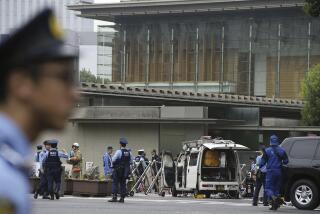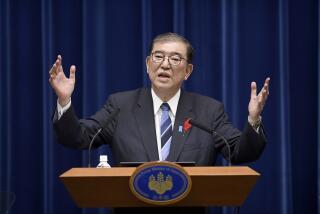Japanese Premier Strives to Ride Out the Storms of Office
TOKYO — Two months ago, Prime Minister Ryutaro Hashimoto appeared likely to become one of the rare postwar Japanese leaders to survive more than two years in a notoriously unstable office.
Today, Hashimoto, like so many of his predecessors, is dancing atop a political trapdoor with the “shadow shoguns”--the former premiers who still wield the real power in Japan--reportedly ready to oust him.
The talk of the town in Tokyo is how long Hashimoto can hold on. Some predict that he may face a crisis as early as the end of November, when the final draft of his embattled administrative reform plan will be unveiled--and may trigger a meltdown within the Liberal Democratic Party, or LDP.
“The Hashimoto Government: The Beginning of the End?” asks a headline in the Bungei Shunju magazine, questioning whether Hashimoto will be ousted before year’s end.
Noted political analyst Minoru Morita argues that the premier will survive at least until spring, when his leadership will be sorely tested by the need to pass legislation to implement the new U.S.-Japan Security Treaty guidelines unveiled this fall.
The Social Democrats face internal pressure to quit their quasi-alliance with the LDP and vote “no” on the security guidelines, giving themselves a platform for parliamentary elections scheduled for July.
Without the Socialists, Hashimoto may not be able to force the legislation through the upper house, where the LDP lacks a majority.
“It’s just become more difficult for Hashimoto to get the guidelines and administrative reforms passed,” said Masaya Ito, an independent political analyst. “And if he doesn’t get them through, he’s finished.”
Hashimoto’s possibly fatal blunder was to appoint an ex-felon, Koko Sato, who was convicted of taking bribes from Lockheed Corp., to a Cabinet office in charge of overseeing administrative reform. The public was outraged.
Sato later resigned, and Hashimoto apologized for misjudging the public mood. But the fallout has not abated. His Cabinet approval ratings plunged to 44.1% after Sato’s appointment in September and slipped again to 43.5% in October, the Yomiuri newspaper poll shows.
Hashimoto has reportedly reached a truce--but only until the end of November--with the zoku-giin, the parliament members who lobby for powerful interests.
*
The man now mentioned as Hashimoto’s likely replacement is Foreign Minister Keizo Obuchi, who leads the LDP’s largest faction, the Keisei Kai. The real power behind the Keisei Kai, however, is former Prime Minister Noboru Takeshita, seen as the man who may decide Hashimoto’s fate.
The premier is fighting back, pursuing international diplomatic successes that will boost his standing back home. He is scheduled to meet Saturday with Russian President Boris N. Yeltsin and will fly to Saudi Arabia a week later. His agenda includes promoting oil and gas deals to ensure supplies for energy-insecure Japan.
Hashimoto’s fans say he has shown grit and gravitas that few of Japan’s leaders can boast, and they warn against underestimating him.
*
Hideyuki Terashima of The Times’ Tokyo Bureau contributed to this report.
More to Read
Sign up for Essential California
The most important California stories and recommendations in your inbox every morning.
You may occasionally receive promotional content from the Los Angeles Times.










